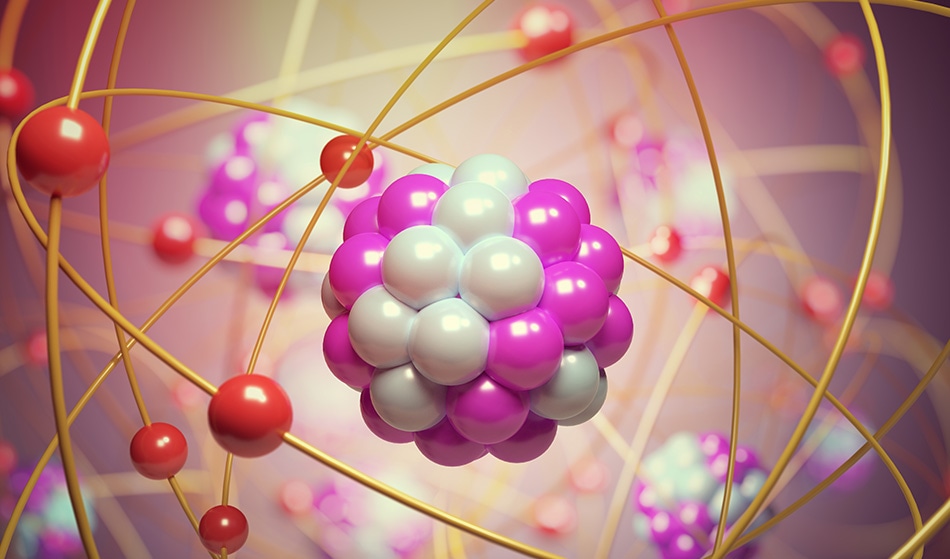-2.jpg) By Thomas HornigoldFeb 26 2018
By Thomas HornigoldFeb 26 2018We’ve known – since even before the Rutherford gold-foil experiment – that the atom is mostly empty space. In all but the heaviest atoms, it’s a helpful picture to think of the electron whizzing around on its orbit far from the nucleus.
 Image credit: vchal/shutterstock
Image credit: vchal/shutterstock
The empty space in the atom is the source of fascination for physicists and laypeople alike. What if it were possible to pack that space with something? This is precisely what has been achieved by new research, published in Physical Review Letters.
By creating what’s referred to as a ‘Rydberg atom,’ where the electron orbital is at a significant distance from the nucleus, the scientists were able to pack that space with additional atoms. The atoms then form weak bonds with each other and a new state of exotic matter is formed, which the scientists refer to as Rydberg polarons. The theoretical basis for the work was done at TU Wien (Vienna) and Harvard University, while the synthesis of the Rydberg polarons was performed at Rice University in Houston (Texas).
The study was conducted under extreme conditions – it involves two states of matter that might best be described as exotic. Close to absolute zero, bosonic matter can condense into Bose-Einstein condensates; meanwhile, Rydberg atoms are atoms in which a single electron is excited into its highest possible bound energy level, such that it orbits at a far distance from the nucleus.
"The average distance between the electron and its nucleus can be as large as several hundred nanometres - that is more than a thousand times the radius of a hydrogen atom," according to Professor Joachim Burgdörfer. With his research partner Prof. Shuhei Yoshida, they have studied Rydberg atoms experimentally and theoretically for years.
These unusual atoms are important for various reasons; studying them allows you to determine accurate measurements for the lifetime of metastable states, which is, in turn, an important test on our understanding of the standard model. Rydberg atoms can also form in plasmas such as the interstellar medium, as electrons recombine with atoms in energetic surroundings. It’s considered that perhaps in the interstellar medium, Rydberg atoms could form and end up stable for far longer than on Earth due to the lack of collisions.
The experimental procedure first involved making a Bose-Einstein condensate with strontium atoms by cooling them down to ultracold temperatures; once they condensed, lasers transferred enough energy to a single atom to excite it into its Rydberg state. Given that the electron orbital radius for the Rydberg atom is far greater than the average distance between atoms in the condensate, you can have dozens of atoms lying within the orbital of the Rydberg strontium atom – perhaps as many as 170.
Interestingly, the atoms don’t have a huge impact on the electron orbital – this is because they’re electrically neutral and therefore don’t exert a huge force on the electron in its orbital. But the presence of the atoms does slowly scatter and perturb the orbit of the electron without ionising the Rydberg atom.
These weak interactions between the electronic orbital and the atoms serve to decrease the total energy of the system compared to condensate without atoms enclosed by a Rydberg atom. Given that the system is in a lower energy state, this process weakly binds the atoms together.
"It is a highly unusual situation," says Shuhei Yoshida. "Normally, we are dealing with charged nuclei, binding electrons around them. Here, we have an electron, binding neutral atoms."
The bond is substantially weaker than the interatomic interactions that we’re used to considering, such as the interactions between atoms in a crystal lattice. Consequently, for this slight perturbation in the energy of the system to become important enough to observe, the temperature needs to remain very low. This form of matter can still provide insight into the physics of Bose-Einstein condensates and physics that becomes significant at ultracold temperatures.
For us, this new, weakly bound state of matter is an exciting new possibility of investigating the physics of ultracold atoms. That way one can probe the properties of a Bose-Einstein condensate on very small scales with very high precision.
Joachim Burgdörfer
Disclaimer: The views expressed here are those of the author expressed in their private capacity and do not necessarily represent the views of AZoM.com Limited T/A AZoNetwork the owner and operator of this website. This disclaimer forms part of the Terms and conditions of use of this website.